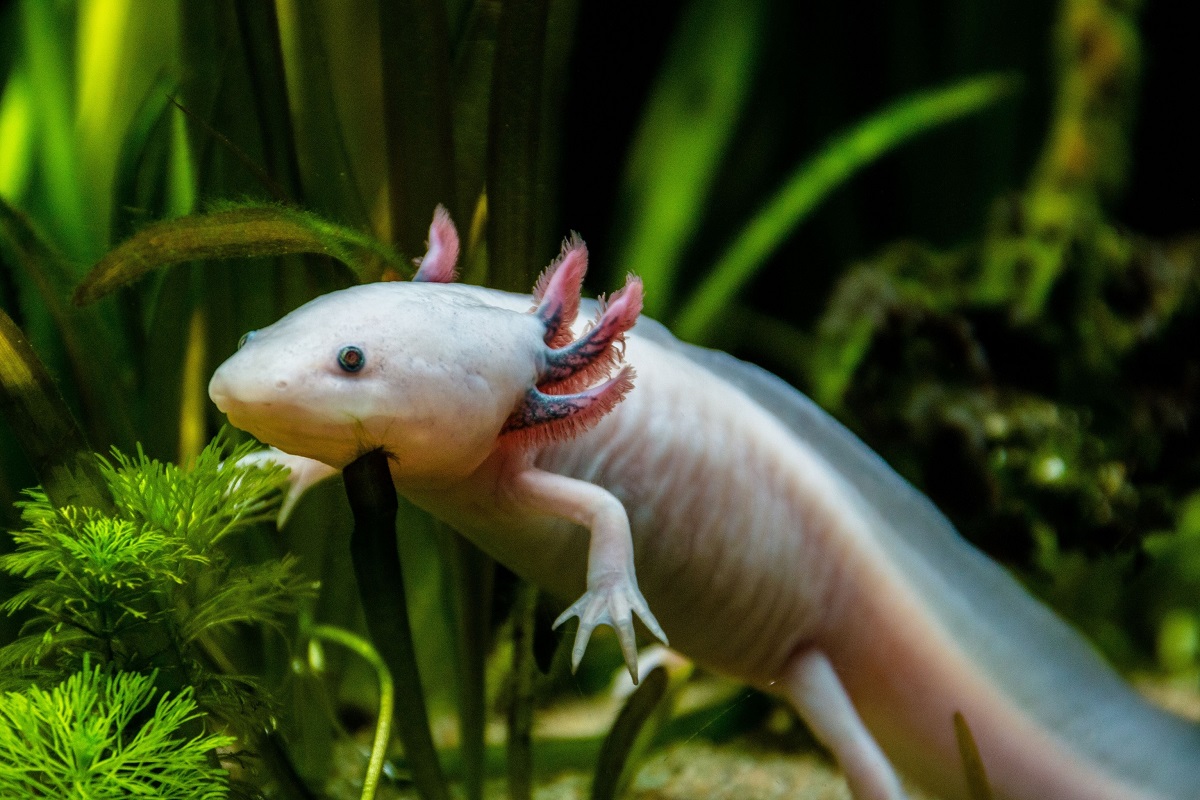Axolotl might not be a highly common pet, but definitely, it is a unique one.
Axolotls are large salamanders who belong to the remnants of lakes Xochimilco and Chalco in Mexico City, Mexico. They live in water and emerge on the land. They are a type of salamander & can be found in different colors such as gray, black, gold & white.
However, unlike many salamanders, they hardly undergo the process of metamorphosis from their larval to an adult form where the breathing instantly changes from gills to their lungs. Thus, they stay aquatic their whole life.
Thus, they are not just petting that you handle. They are very much entertaining to watch. The axolotl is relatively easy to care for & hardy, making them well suited for beginner pet owners. Additionally, their dietary requirements are hardly straightforward.
However, as they live their whole lives in water, their owners should be able to provide them with an adequate axolotl tank, which must be kept at the correct temperature for this particular animal to thrive.
The requirements of an Axolotl are minimal, and provided that the temperature and water flow are well controlled, they are easy-to-care-for captives that breed readily in captivity.
It isn’t easy to think of a more impressive display animal than the Axolotl, and its bold and tame nature makes it an attractive and interactive pet.
Contents
Axolotl Behavior & Temperament
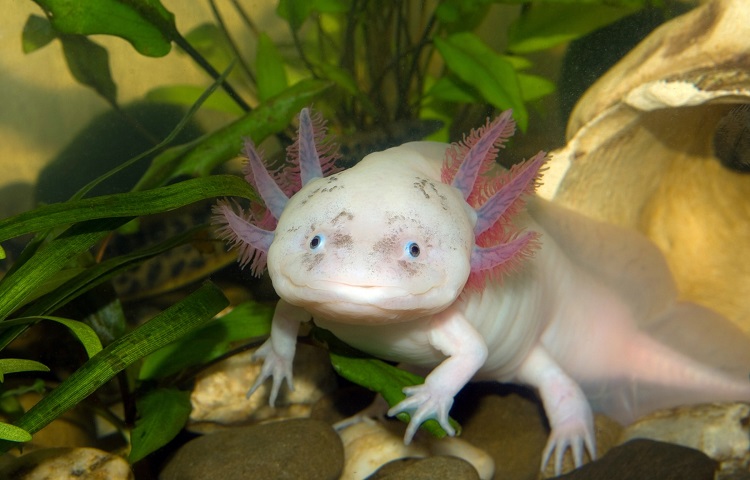
While the axolotls are hardy to slight fluctuations in their surroundings, they even have a soft, delicate body with permeable skin.
Moreover, mainly their body contains cartilage instead of bones. It means you should not handle them until it is necessary. Those who require moving the axolotls out of their aquarium tank should ensure to do with a fine-mesh net as it would prevent entangling of any of their body parts.
Once you get their housing setup the right way, you usually require spending a few hours every week cleaning and feeding them. Axolotls generally tend to get pretty bold & are perfectly content to move in their axolotl tank while humans enjoy watching them peacefully. Few just come up to the edge of their tank when any individual is closely observing them.
However, they are not social animals & do not need any tank pals. They must not be kept with any other animal or species as axolotls tend to eat pet fishes, and sometimes fishes may nip at them even. One also must be cautious regarding housing them with various other axolotls.
Child axolotls are cannibalistic towards their counterparts; thus, they are best if raised in a completely separate enclosure. Adult axolotls, in some cases, can be housed together; however, ensure to watch for cannibalistic tendencies. If any of their body parts are bitten away by their tank mate, the axolotl has the potential of regenerating it with time. However, to avoid such situations is best.
You also shouldn’t miss:
What Size Tank Do I Need For An Axolotl?
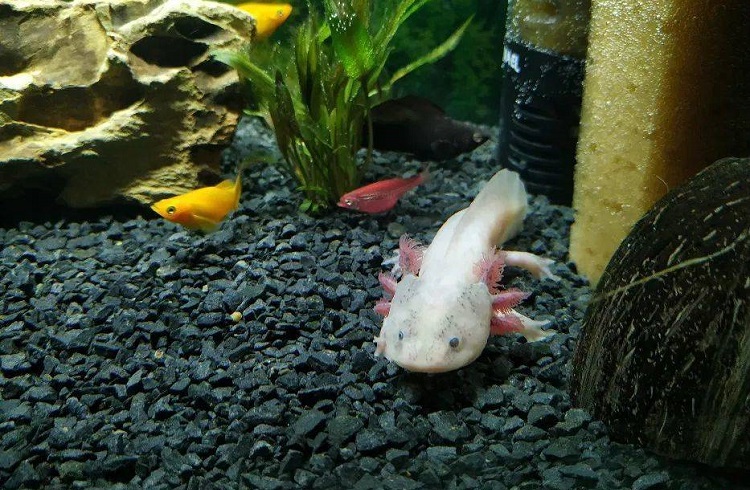
Each Axolotl requires a certain amount of space to survive and live. Buy at least a 20-gallon tank for a single axolotl. If you want to keep two axolotls, you must double the size and get a 40-gallon one.
That’s all you need to extend it by 20 gallons for every additional Axolotl. Buying a bigger tank is a better idea because your salamander will have more space to move around and thrive. Also, it will save some time as you won’t have to change the water frequently.
For such aquatic species, the tank’s land area is nothing but unnecessary. At the minimum, the water depth should be a little more than the axolotl’s length. However, adding in additional depth would assist with water quality & endow animals with adequate room to freely move.
Ensure to keep the tank in a completely cool room and mostly away from bright sunlight with a water temperature of 57 to 68 degrees Fahrenheit or between 14 and 20 Celsius. Ensure the temperature does not get over 75 degrees Fahrenheit or 24 Celsius.
They do not require any special lighting; for them, a dark hiding spot, laid beside their side or any aquarium castle would be best. Few of the owners generally leave the bottom of the tank bare, while others think this may stress them if they cannot get an adequate foothold on the smooth bottom.
In case gravel bottom is used, it should be coarse gravel, which is bigger than the head of the axolotl. Fine gravel may be ingested by them that may create obstruction.
Tap water treated with aquarium water conditioners that eliminate chloramines and chlorine is best for axolotls. Avoid using distilled water and ensure the water’s pH stays from 6.5 to 7.5. Most owners usually find the filtered aquarium is simpler to maintain as unfiltered water requires constant changing to eliminate the waste.
However, for those who opt for filters on their axolotl tank, the filtration rate must be slow. A powerful filter that creates extremely strong currents can be stressful for axolotls.
For the filtered tank, cleaning generally consists of 20 percent water change every week and siphoning waste from the axolotl tank’s bottom.
You should conduct a 20% water change regularly every day for those not using filters. Avoid doing complete water change as it can alter water chemistry differ drastically & stress your animal.
What Type Of Aquarium Do I Need?
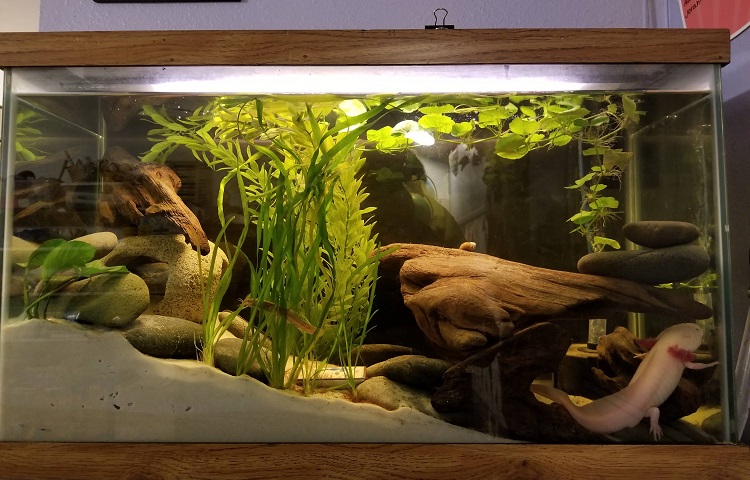
Aquarium for axolotl is a matter of great preference, but specific problems must be noted. Small and young species can be kept at the standard 10-gallon aquarium. Note that adults should be kept in larger tanks.
They specifically are nocturnal. Thus, bright lighting with minimal or few hiding places would be stressful for the axolotl. They like to be in areas where they can easily hide in the daytime. Aquarium thus should consist of a hiding shelter such as PVC pipes, stacked rock, hollow ceramic decorations, & even hollow ceramic rocks utilized for cichlids make a good hiding spot for axolotls. Various other decorations are just optional.
However, anything in the tank must be smooth with zero hazardous rough edges or sharp points. There must be more hiding places than other species in the tank. It enables them to avoid each other easily & can assist prevent their aggressive behavior that can lead to missing limbs, stress, and even death in the worst-case scenario.
What About Filters?
Filtration can be way tricky when considering axolotls as few fish rules do not apply. Axolotls prefer slow-moving water & high flow, which can prove very stressful.
Sufficient filtration to keep the tank clean is crucial for water health and quality, but water flow should be kept low. One of the great options is sponge filters, as they cater to effective filtration when creating a relatively low flow compared to other power pumps and filters. Also, they are good as they assist increase oxygen levels and aeration.
In case any other filter is used, it is crucial to ensure that axolotls cannot get stuck to intake & that filter does not create much flow. Excessive stress from the high flow is evidenced by those axolotls that hold their gills curved way forward than usual.
What Is The Best Temperature For Axolotl?
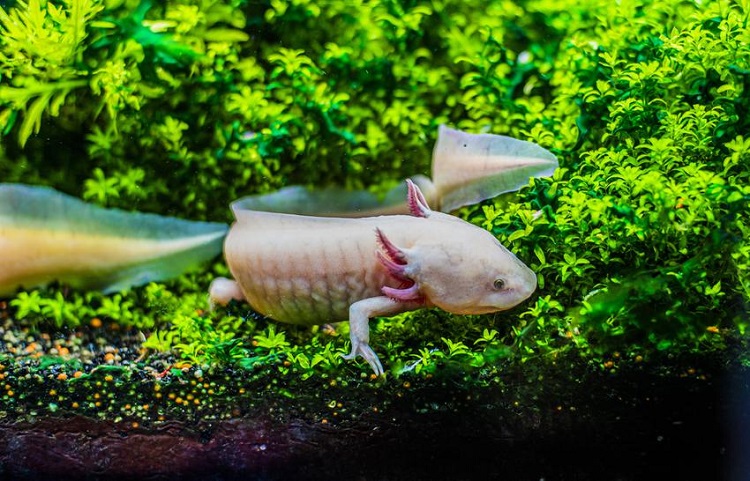
Captive care for such animals is way easier. However, few specific problems are way crucial for their long-term health. One such critical problem is when it is about their care temperature.
Axolotls are thoroughly cool water species and are thus stressed by relatively higher temperatures. It might seem very odd as such animals are from Mexico and are intolerant to heat.
The lakes they belong to are of higher altitudes and thus are way cooler than low altitude climates of similar latitude. Usually, temperatures of over & around 75 degrees Fahrenheit are stressful, and for an extended period, such temperature can instantly result in death and illness.
A temperature lower than 70 degrees Fahrenheit and those between 70 and 74 degrees Fahrenheit is problematic.
The warmer the water, the lesser is the need to hold the oxygen. Adequate aeration can make a vast difference between the unhealthy and healthy axolotls in this kind of borderline temperature situation.
Fish Mates for Axolotl
Compatibility is a highly debatable topic about any aquatic species. And axolotls are not at all an exception.
Most of the keepers of axolotl make sure not to keep them with any other kind of animals for plenty of reasons. One such reason is their external gills & slow nature makes them easy and swift targets for other fishes. Even the slow fish find the external gills very tempting & have an urge to make it their meal.
The next problem is axolotls are by nature nocturnal & can make an easy meal for those sleeping fishes during the night. Thus, it is nearly difficult to get an acceptable tank mate that is neither very small to get eaten or very aggressive to make a meal of axolotl’s gills.
Can Two Axolotls Live Together?

Axolotls are not at all social animals, so they do not require any pal for entertainment purposes. It is ideal for the house axolotls to be together if they are a rough or similar size.
If one of the axolotls fits easily into one another’s mouth, there are high chances one of them may end up getting smacked. Generally, axolotls evolve into the cannibalistic phase once they develop four limbs. However, some may retain those instincts.
Also, note if you house a female and male axolotl together, they most likely may end up breeding. Young larvae may not be simple to take care of.
Several people wonder that axolotls are aggressive and shouldn’t be housed in the same tank. You have to follow some essential rules when keeping tank mates, but axolotls are not typically aggressive, but they’re just aggressive eaters.
Things to avoid here:
- House axolotls more than 1 inch apart in size should not be kept with each other. Axolotls have poor eyesight and will nibble at anything that moves, thinking it is potential food. Axolotls that differ significantly in size could sustain injury by accidental bites, or if one is tiny, it might result in death or being eaten entirely.
- House males and females together. Males will constantly push a female to breed and harm her health in the long run. Enduring badgering and egg production can make for a rather unhealthy axolotl.
- Accommodating multiple axolotls in a small enclosure can be dangerous. Axolotls need to start with at least 20 gallons as the more significant the tank footprint, the better, so pick a 20 gal long over a standard 20 gal and add 10 gallons per Axolotl. So if you have four axolotls, it would be most suitable to have them in a 40-gallon breeder tank (long and low tank).
What you should do:
- You should keep axolotls of the same size and the same coupling.
- You must have places for them to hide and feel comfortable so they can thrive.
- Have clean and cool freshwater
- Feed them an appropriate diet as hungry axolotls are far more likely to have accidental nips and bites.
Caring for an axolotl
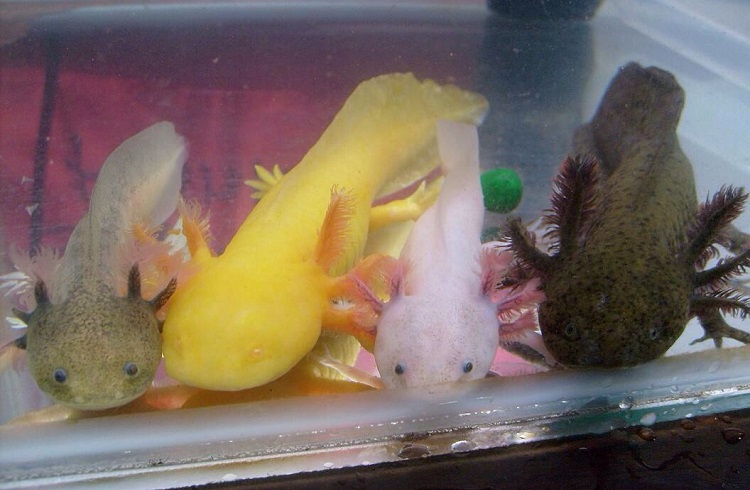
Axolotls have virtually no actual bone in their bodies, mainly when they are young. Their skeleton is primarily cartilage, and they are covered by permeable skin.
These animals are delicate and soft-bodied amphibians. Axolotls should not be handled unless necessary, and they can be quite a handful to catch through a net. If you are using a net to move an axolotl, make sure you don’t use nets with mesh that would let an axolotl’s fingers get destroyed. Utilize a soft net or mesh for them.
Once your housing set up for an axolotl is completed, you typically only have to spend a few hours per week feeding and cleaning. The rest of their time is to enjoy them as a quiet, aquatic buddy.
Axolotls tend to be pretty bold and ideally move about inside their tank as humans watch them. Some animals will come up to the side of their tank when a person is there observing them and their smiley faces are indeed a joy to look at.
Tank Companions
However, they are not particularly social animals and don’t require tank companions. It is suggested that they are not kept with different species as axolotls might attempt to eat pet fish.
Also, the fish sometimes nip at them. It would help if you even were cautious about housing them with other axolotls. Juvenile axolotls can be cannibalistic toward one another, so they are best raised in separate partitions.
Adults can potentially be housed together, but you will need to watch out for cannibalistic tendencies. An axolotl can regenerate itself over time if a body part gets bitten off by a tank mate. However, it’s still better to avoid this situation altogether.
Young axolotls often nip at or bite off the legs and gills of their tankmates, so they should only be kept together if fed well and given plenty of space.
Axolotls larger than 5 inches tend to be safer tankmates, and adults rarely have conflicts. They are not social beings and do not benefit in any way from having a companion axolotl. Keeping multiple axolotls is purely for the keeper’s benefit and breeding.
Due to the nipping tendencies, other fish should not be kept with axolotls. It is best if an axolotl aquarium should contain only axolotls!
Common Health Problems faced by Axolotl
Their regenerative powers are a crucial characteristic of axolotls. For injuries that aren’t life-threatening, they can regrow parts of their limbs, tail, and other body parts, and they can even regenerate the heart and eye tissue.
However, this extraordinary ability of an axolotl doesn’t protect them from all health issues that fishes and exotic pets undergo in their lifetime. Unsanitary tank conditions can cause viral or bacterial infections, the signs of which include the Axolotl being tired and a lack of appetite.
In addition to this, ammonia buildup from waste in the tank can be highly toxic. It can interfere with the respiratory process, causing gills and neurological damage if this happens. They might not be able to breathe correctly and be sluggish in their behavior.
Moreover, axolotls with gravel in their tank that’s diminutive enough to eat are prone to gastrointestinal obstructions. If your Axolotl encounters an obstacle, it will likely be sluggish and not want to eat. And if it’s not promptly treated, death can happen quickly, and that’s not what you would like.
Also, axolotls rarely do experience metamorphosis into a terrestrial form. The metamorphosis can be highly stressful for an axolotl, significantly shortening its lifespan.
Suppose you notice abnormal changes to your animal’s body, such as it beginning to grow larger, puffiness around its stomach, unnatural breathing patterns. In that case, it’s best to have a veterinarian who specializes in exotic pets examine it as soon as possible.
Food for Axolotl

Axolotls are carnivorous, so in the wild, they love eating worms, insects, small fish, and typically anything that fits into their mouths which they can swallow as a whole.
When you keep Axolotl as pets, you should be feeding them a similar diet. A combination of live and dead foods is okay for them. Including:
- Earthworms (live nightcrawlers)
- Bloodworms
- Frozen brine shrimp
- Shrimp
- White worms
- Daphnia
- Axolotl pellets
- Repashy Grub Pies
The amount of food you feed your Axolotl will differ depending on the age and individual. You can slowly feed until it stops eating and ensure not to overfeed them.
Axolotls stop eating after they are full so that you can use this as a marker to stop. And always remember to remove any uneaten food from the tanks as it can further cause contamination.
Axolotls feed on snails, small fish, worms, crustaceans, and small amphibians in the wild. They can be fed various brine shrimp, small strips of beef or liver, earthworms, bloodworms, tubifex worms, other frozen fish foods, and commercial fish pellets in confinement.
You should not feed any worms or fish you have caught yourself because those can carry parasites that harm the animal. Usually, no vitamin or mineral supplements are necessary for axolotls.
You should consult your veterinarian about the amount of food to offer. Also, you should enquire how often to feed your Axolotl, as this changes depending on age and size. Many adult animals need two to three feedings per week.
One of the best feeding methods is holding the food in round-nosed forceps in the tank near the animal. You also can drop the food as close to the Axolotl as possible.
If your Axolotl does not eat much during the day, try feeding it in the evening when it’s generally more active. You must remove any uneaten food from the tank every day to clean the water.
Setting up the aquarium for Axolotl, how to maintain it
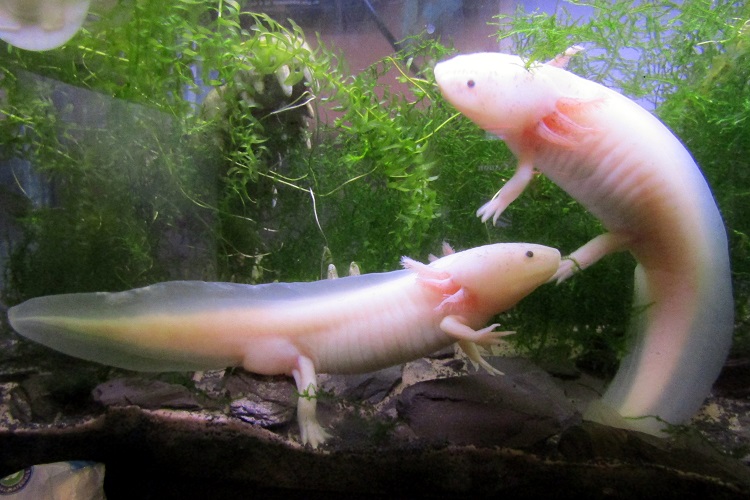
Axolotls can be sensitive to poor water conditions. Follow the instructions below to ensure you provide the proper maintenance for your Axolotl to live a healthful life.
- Firstly, you need to pick the right tank. You can get away with a 10-gallon aquarium for your Axolotl, but you will find it much easier to handle the animal in a 20-gallon tank. Axolotls can produce a lot of waste, so by giving them a large body of water, you can help keep your tank’s water parameters stable. It would be best to give more importance to floor space over height.
- For the flooring, you have two options: sand or bare bottom. A bare bottom tank makes it uncomplicated to clean and maintain your tank, and yet, if your pet cannot grip the surface, it may become worried. Some owners leave the bottom of the tank bare, although others believe this might stress the Axolotl if it can’t get a grip on the smooth surface. If you use gravel on the bottom, it must be coarse gravel that’s more prominent than the Axolotl’s head. There’s always a risk as the fine gravel can be swallowed by the Axolotl and cause an obstruction.
- Ensure the tank has a secure lid, as it’s not unusual for these animals to try to jump out of their enclosure. A land area is not necessary for the tank for these entirely aquatic animals. At a minimum, the water depth should be slightly more than the length of your pet. But adding extra depth will help with the quality of quality and give your animal more room to move.
- You should keep the tank in a cool room away from bright sunlight. The water temperature must stay between 57 and 68 degrees Fahrenheit, and don’t let it get above 75 degrees Fahrenheit (24 degrees Celsius). Unlike reptiles, no special lighting is required for axolotls, and they often enjoy a dark hiding spot. You can use a flower pot laid on its side or an aquarium castle.
- You should never use distilled water. The pH level of the water must be between 6.5 and 7.5. Most owners find a filtered aquarium is more manageable to maintain. Unfiltered water requires frequent changes to get rid of the waste. However, the filtration rate should be slow if you select a filter. Powerful filters that create strong currents in the tank can create stress for an axolotl.
For a filtered tank, cleaning takes a 20% water change each week and siphoning waste from the bottom of the tank.
And if you do not go with the filter, you will have to do a 20% water change daily or every other day. Never do a complete water change, which can drastically alter your animal’s water stress.
Water Parameters For Axolotl Tank Setup
Maintaining the correct water conditions is vital to your Axolotl’s health, wellbeing, and longevity, and it can make them sustain for a more extended period.
- Temperature: 60-70°F (15-23°C)
- pH: 6.5-8.0
- Chlorine and Chloramines: 0 ppm
- Ammonia: 0 ppm
- Nitrite: 0 ppm
- Nitrate: 0-10 ppm
- General Hardness: 7-14 GH
Carbonated Hardness: 3-8 KH
Do Axolotls Like to Be Touched?
Axolotls are very delicate species and do not like being touched very often.
Though you can touch them, you must keep certain things in mind before doing so. The initial thing is to properly wash your hands before touching them and then touch them gently.
Moreover, avoid forcefully touching them; first, bring your hand forward and allow them to touch first to make a move.
Conclusion
Axolotls are not complicated at all, and although their maintenance is complex, they make for great pets.
If you don’t keep juveniles in the tank that are different in size, things will be fine. But even if you have two different sizes, you can keep them in separate tanks until they grow up to be similar and then keep them together.
Keeping only one Axolotl is probably the best, but it is up to you. You would want to see at least two of them play with each other, and an axolotl will add more beauty and ambiance to the environment.
Taking care of more than one Axolotl is also more exciting and challenging, and it will prove to be an excellent experience for everyone overall.

Ian Sterling, founder of Fishlab.com, began his aquarium journey over 30 years ago, driven by a deep fascination for fish and their diverse personalities. His website, Fishlab.com, is dedicated to making fishkeeping accessible and enjoyable, offering beginner-friendly guidance, expert insights, and a community for aquarists to connect and share experiences.


